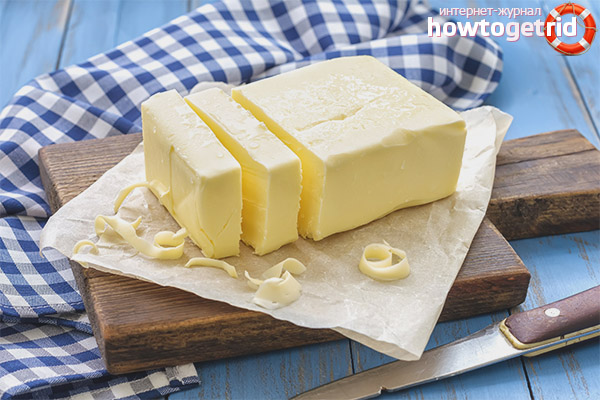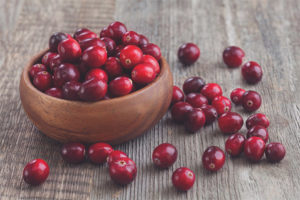The content of the article
Any kind of oil belongs to the category of oily products. Butter is also included in this group, because in it, in addition to fats, there is still a high content of carbohydrates. But a nutritious diet without this basic product of any diet will be scarce and inferior. Therefore, despite all the risks, nutritionists recommend using butter even in severe forms of diabetes.
Of course, such a diet will be limited. Particular attention should be paid to a sick person when choosing a product for their table and the optimal portion, the use of which does not harm health. These key points, as well as the benefits of a popular product, will be discussed in this article.
Composition
To some extent, the composition of butter is unique, because the components collected in a single product perform not only their main functions, but also simultaneously solve other important tasks.
Approximate composition:
- Saturated fats - their share in the product prevails over other components (in 100 g - more than 81 g of fat).
- Proteins - there are only 0.9 g.
- There are few carbohydrates - only 0.2 per 100 g, which makes the oil available for diabetics.
- Retinol (Vitamin A) - the share of this agent is 0.72 mg, which is a third of the daily requirement for this element.
- Carotenes - a little more than 0.5 mg.
- Cholesterol is presented in oil seriously - 208 mg.
- Mineral elements together occupy about 0.3% of the composition.
Separately, it should be noted that in high-quality oil, carotene acts as a natural dye. In a product with a low (less than 62%) fat content, manufacturers often add emulsifiers, trans fats, stabilizers and other “chemicals”. For this reason, people suffering from diabetes should prefer natural products with a fat content of 72 to 81%. All kinds of spreads and margarines in the diabetic menu should not appear in principle.
Useful properties of oil
The most important characteristic inherent in oils is the ability to quickly saturate the body. Also in the category of advantages should be attributed to the high palatability of the product. It is hard to imagine, for example, side dishes without an oil additive. Such a lean dish, a person is unlikely to eat with appetite. In addition to these characteristics, butter has the following capabilities:
- Saturates the body with the energy necessary for the implementation of important processes.
- The product has a pronounced wound healing effect, which is often used in home treatment.
- Another property that I want to pay attention to is the ability to influence the course of metabolic processes.
- Due to the cholesterol content, butter stimulates the production of sex secrets in the female body, to a certain extent, it contributes to conception and regulates the menstrual cycle.
- Also, oil stimulates the production of bile acids, improves brain activity, prevents the development of oncology.
Summarizing all the above characteristics, we can conclude that butter is an extremely useful product for the nutrition of people with high sugar.
What are the risks associated with the use of the product
The presence of a large number of positive qualities does not exclude cons. With all the advantages of butter, a product can have a negative effect on the diabetic. The main disadvantage is the relatively high glycemic index.In oil, it is 51 units, so with type 2 diabetes, it should be used very carefully, and if possible it is better to replace it with a similar product, whose GI is lower.
Vegetable oils are suitable for this purpose: olive, sesame, linseed. In these samples, the GI is almost zero and they do not contain "bad" cholesterol.
Norms of oil for diabetics
Although butter is not on the list of products prohibited for diabetics, it should be consumed in strict compliance with the established norms. Since the daily portion of fat for diabetics should not exceed 15 grams, this dose should be evenly distributed in the daily menu. If you adhere to this rule, you can enjoy the taste of your favorite product without risking complicating the course of the underlying disease.
Butter cannot be completely replaced even with the highest quality analogue, because it contains fat-soluble vitamins. There are no such components in vegetable oils. In general, for each patient, the doctor selects an individual dose of a particular product. This is done on the basis of laboratory data and the general well-being of a sick person. Therefore, an indicator of 15 grams is an approximate guideline.
Rules for including butter in a diabetic's diet
As already noted, the feasibility of including any food product in the diet program of a diabetic is evaluated by specialists. Butter is a high-calorie product, so the proportion of its presence in the diet should be determined only by a doctor.
If a person has a high cholesterol, then the allowed serving of this product will be minimal. But even a small amount of good quality oil will provide the body with the necessary complex of substances, as well as improve the general condition of a person with diabetes.
The product can be added to first courses, dessert and side dishes. It must be used very carefully with type 2 diabetes, because oil with this form of the disease prevents the normal absorption of glucose from food. As a result, sugar builds up in the blood. It is also worth considering the fact that most patients with the second type of diabetes experience problems associated with being overweight.
Which oil is the best
You can avoid many troubles if you choose the right oil for a diabetic. On the shelves of stores there is always a rich assortment of products of this category, but not all grades of oil are suitable for feeding a sick person. We characterize popular product samples:
- Amateur oil - it contains a little fat, but a lot of moisture.
- Sour-creamy varieties are produced on the basis of high-calorie cream and sourdough.
- Sweet cream butter also contains fresh cream.
- Product with various excipients: cocoa, vanilla, fruit additives. This oil has a pleasant taste, but the role of additional components must also be evaluated.
Sweet and sour oils are more suitable for the diet of people with diabetes. Typically, this information is indicated on the packaging. To verify the satisfactory quality of the product, it is enough to conduct a simple test: in a glass of warm water you need to dip a small piece of cream product. If the oil dissolves in a minute, and a film appears on the surface of the water - a good quality product. Poor quality oil in hot water will dissolve without the formation of a film.
Conclusion
Diabetes is a specific disease. With proper treatment and adequate nutrition, a person may well lead an active lifestyle, without denying anything to himself. Therefore, it is very important when drawing up an individual program for a diabetic to find a balance between these important components. At the same time, physical activity for patients with such a diagnosis is useful, but smoking with alcohol is undesirable companions.
Video: extraordinary properties of butter












Submit